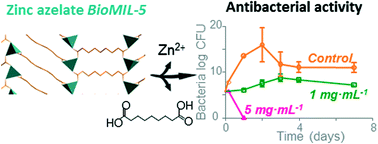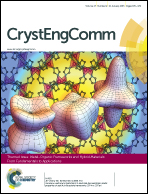A Zn azelate MOF: combining antibacterial effect†
Abstract
A novel biocompatible and bioactive Metal–Organic Framework (BioMOF), named BioMIL-5 (Bioactive Materials from Institut Lavoisier), was hydrothermally synthesized from a Zn2+ salt and azelaic acid, both with interesting antibacterial and dermatological properties. Its structure was determined by high resolution X-ray powder diffraction, and further characterized by infrared spectroscopy, thermogravimetric analysis and elemental analysis. The determination of the minimal inhibitory concentration (MIC) and minimal bactericidal concentration (MBC) values of BioMIL-5 in Staphylococcus aureus and Staphylococcus epidermidis demonstrated that the antimicrobial activity of the individual components of BioMIL-5 were maintained after its synthesis. Moreover, BioMIL-5 was found to be stable in water and in bacterial culture medium, especially in water, leading to the subsequent progressive release of its active constituents, AzA and Zn2+ ions. Interestingly, this slow active delivery allowed control of the growth of a S. epidermidis suspension over 7 days. The high stability of this material and the maintenance of its antibacterial properties make BioMIL-5 a good candidate for future bioapplications, for skin care and in cosmetics.

- This article is part of the themed collection: Metal-Organic Frameworks and Hybrid Materials

 Please wait while we load your content...
Please wait while we load your content...